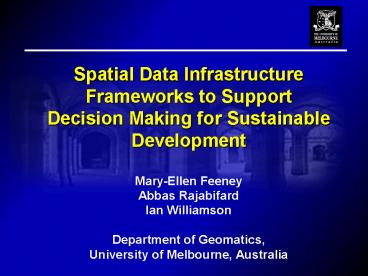Spatial Data Infrastructure Frameworks to Support PowerPoint PPT Presentation
1 / 25
Title: Spatial Data Infrastructure Frameworks to Support
1
Spatial Data Infrastructure Frameworks to Support
Decision Making for Sustainable
DevelopmentMary-Ellen Feeney
Abbas Rajabifard
Ian Williamson
Department of Geomatics,
University of Melbourne, Australia
2
Overview
- Decision making for Sustainable Development
- SDI Concept and Decision making
- Brief Introduction to the concept of DSS
- The DSS SDI context
- Impacts for Developing SDIs to support DSS
- Exploratory Case Studies of different SDI
- Models for DSS support - regional Australia
3
Decision Making for Sustainable Development
4
Decision Making for Sustainable Development
Economy
Society
Ecology
From Bellamy 2000
5
The SDI concept Decision Making
The principle objective for developing SDI is to
achieve better outcomes from spatially related
economic, social and environmental
decision-making.
6
Components of SDI
Dynamic
7
(No Transcript)
8
How do SDIs support Decision Making?
- Through facilitating the provision of
standardised, interoperable datasets and
information that are accessible, useable,
exchangeable
- But, are data and information enough to support
decision making?
9
The Nature of Decision Making?
10
Decision Support Systems (DSS)
- Generally computer-based information systems
- Support decision-making activities in the
exercise of judgement - Do not actually make the decision
- Characterised by integrated modeling and analysis
facilities, including
11
Decision Support Systems (DSS)
- tools for obtaining, analysing presenting
information
- modeling simulation tools
- multi-criteria modeling for selecting from a set
of defined alternatives
- Expert systems for rule-based decision making in
defined situations
- Life-cycle analysis green design tools.
12
Decision Support Systems
- Generally combinations of SYSTEM tools
- Aid rather than replace decision makers
- Can restrict or expand decision options
- May facilitate user-directed change
- Can be for specific decision environments/
generic tool
13
Decision Support Systems vs Tools
- complexity ie.
- number of criteria
- incorporate preferences values
- number of decision-makers ?
- decision-making model
- support existing data gaps in data
- generation of alternative (prioritised)
solutions
14
DSS SDI CONTEXT
Relevance and Significance ?
- Why
- What
- How
- When
15
DSS SDI CONTEXT
- Capability to validate data quality,
- Process data quantity quickly effectively
- Model new and more variable decision making
16
DSS SDI CONTEXT
17
Developing SDIs to support DSS ...
- understanding of others data needs/resources
- awareness of data availability, quality
limitations
- Improved data by publishing standards
coordination.
- Increased confidence in data use - consistency
- Precipitant for collaborative data-sharing
agreements.
- ?data availability, collection, storage, access,
- users with differing expertise in the GI use
- incentives to integrate social, environmental,
economic spatial data
- transfer of RD to stakeholders
18
Classification of Different SDI Models
- 1. motivation for development
- 2. expected outcomes
- 3. management
- 4. participants
- 5. measures of progress
- 6. political/administrative function
- 7. time frame-committment
19
Herbert River Information Centre- QLD
Developing SDI using a Product Model
1. Sharing/modification existing datasets,
collection of key additional datasets 2.
integrated databases of region 3. unincorporated
partnerships between 11 agencies 4. private
public sector (3 tiers) 5. Completion of the
Mapping Project on time 6. Regional
(Sub-State) 7. fixed project period - 3 years
20
Herbert River Information Centre- QLD
Developing SDI using a Process Model
1. Resource that supports spatial decision-making
planning for natural resource management 2.
Resource Information Centre- GIS facilities,
consultation, project management, data access
coordination 3. HRIC Management - Independednt of
partners, 4. 6 partners - private public sector
(3 tiers) 5. Financial Objective Sustainability
- 3 years-10 6. Regional (Sub-State) 7. 10 year
(period after which partnerships reviewed)
21
Integrated Information Management System - NSW
QLD
Developing SDI using a Process Model
1. Facilitate discovery use of resources for
Catchment Management Decision-making 2.
Information Management Systems incorporating
access to data Modeling Systems 3. University
Government Partners, Govt. Funding 4. 3 partners
- 2 State public sector, University QLD 5.
Establishment, Prototype testing Feedback 6.
Regional (Sub-State) particularly
Catchment-oriented 7. Dependent on Community
Agency Uptake
22
Conclusions
in decision support for sustainable development...
- Process Models for SDI development
- offer access networks to data
- forums of consultation (web-based or service
centres) - DSS to support the application modification of
data
- Product Models for SDI development
- improved data availability, coordinated
collection, cross-agency data collaboration - integrated data products with defined quality
maintenance time-frames
23
Acknowledgements
These findings are from exploratory case studies
in ongoing PhD research. They provide a
broad-brush review of initiatives central to
State SDI developments in Australia. They result
from pilot-work in selecting testing criteria
for the comparison of SDI DSS developments that
is undergoing continuing development refinement.
- Land Victoria of the Victorian Government
- Land Property Information Centre of NSW
- Department of Technology Management NSW
- Australian Research Council
- Spatial Data Infrastructure Research Group,
Department of Geomatics, University of Melbourne
24
International Symposium on SDI 19-20
November, 2001 University of Melbourne,
Australia
http//www.sli.unimelb.edu.au/SDI
25
- Symposium Purpose
- To explore the institutional and technical
issues influencing the development of SDIs. - To examine and debate the directions of
development of SDIs in the future.
Web-site http//www.sli.unimelb.edu.au/SDI Emai
l sdi_at_sunrise.sli.unimelb.edu.au
Registration Deadline October 31

